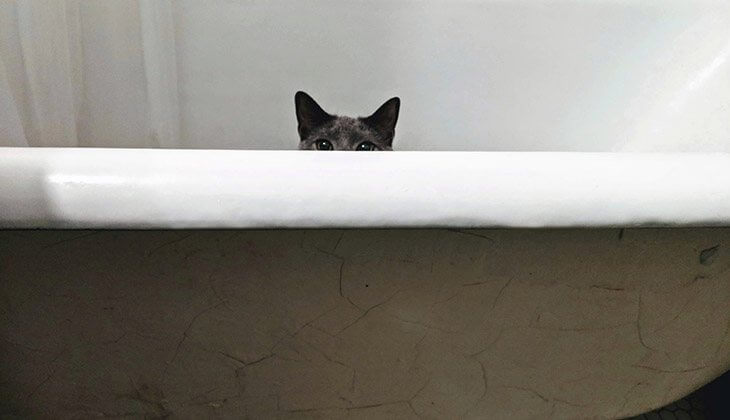Giving your cat a bath
CATS
10 Jul, 2019
READ 5 minutes

You just cleaned the house, and you look down at your cat who has just created a trail of muddy paw prints. We bet your first instinct is to give a bath to your cat’s paws. You wouldn’t be wrong in thinking this. It’s a great solution if you know for sure that your cat doesn’t mind water, but if you’re not sure or you know that your cat really doesn’t like water then what can you do? The last thing you need is a muddy cat freaking out, scratching and trying to run away the minute you turn on the tap.
Believe it or not, most cats do not need to be washed with water. They do a great job licking themselves clean. They have unique tongues with tiny barbs which they use to comb through their fur. In rare instances, when they can’t clean their fur on their own, it may be required to wash them. For example, if they soil themselves in their litter box or get dirty playing outside, they may need washing. For most other things, regular brushing/combing of their coat is enough to keep them clean and comfortable. In the rare event you need to wash your cat, here are some helpful tips.

1. ALWAYS PREPARE YOUR CAT’S BATH BEFORE YOU START
Some items you’ll need are cat shampoo (or mild baby shampoo if you don’t have it on hand), a large jug (or a gentle spray nozzle if you have one), a large towel, cotton balls to clean the ears & a small cloth to clean the face. Make sure these items are at arm’s reach.
2. BATHE YOUR CAT IN A SINK OR A BASIN IF POSSIBLE
It is easier to bathe your cat in a sink instead of having to immerse them in a large tub of water. Fill the sink with about 5-8 cm of warm water. Use the same temperature water you would use for a baby, so you don’t scald your cat’s skin.
3. USE A COTTON BALL TO CLEAN THEIR EARS
Most cats do a great job of keeping their own ears clean. Their grooming habits are so meticulous that they will even clean behind and in the inner flap of the ears. It is a good idea to frequently check your cat’s ears to look for problems lurking inside the ears that could become more serious.
So check your cat’s ears. If they’re clean, then there’s no need for you to do anything. If they don’t appear squeaky clean, then you should clean them with a cotton ball.
Never put any object in your cat’s ear, including cotton buds. This is dangerous and can result in injury.

4. USE A DAMP CLOTH TO WASH THEIR FACE
Cats hate it when water is splashed on their face. This can cause your cat to flinch and try to escape. To avoid causing your cat distress, use a damp cloth to clean their face and around their eyes, nose, whiskers, and mouth. Be sure to avoid getting water and soap into your cat’s mouth, ears, and eyes. These are sensitive areas which can easily get irritated.
5. SPEAK GENTLY AND IN A CALMING VOICE
This will help put your cat at ease and make their bath a bit more tolerable. Loud noises can startle a cat so try not to get frustrated or raise your voice as this can cause your cat stress. Also, keep in mind that the less restrained they are, the more likely they are to cooperate. Be gentle when bathing them.
6. REWARD YOUR CAT WITH A TREAT WHEN BATH TIME IS OVER
Positive reinforcement is always a good thing. When you give your cat a treat after bath time, you are helping them equate bath time with happiness because, of course, treats = happiness!
Do not hesitate to reach out to a veterinarian or professional groomer if you need advice on bathing your cat. It can certainly be challenging but the good news is, you don’t have to do it often and if you do it right the first time, it will make the next bath time so much easier.








